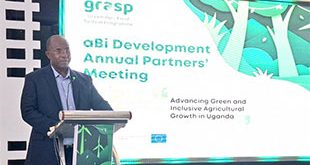
Amuru, Uganda | THE INDEPENDENT | Several acres of crop gardens are drying up in Amuru district due to the prolonged dry spell that has persisted since May this year. Like in other parts of Northern Uganda, farmers in Amuru had planted a variety of crops including beans, maize, rice and ground nuts among others in the first planting season.
Most of the crops had started blooming and flowering but have now started withering and drying up due to the prolonged dry spell leaving farmers in panic. Richard Tekuma, a farmer in Lajalula in Lakang sub county told URN on Monday that his four and a half-acre of beans and groundnuts that should have been ready for harvest next month have dried up.
He explained that the harsh weather has dashed his hopes, raising fears of food insecurity. Peter Okot Ongole, another farmer is also worried after his two acres of maize and rice dried up due to the prolonged dry spell. Ongole said that he was expecting to raise several bags of cereals from the crops which had earlier bloomed very well but all these have been shattered.
Francis Odida, the Lajalula local council one chairperson whose three and a half acres of rice and groundnuts have also dried up disclosed that more than 100 acres of crop gardens in the area have gone to waste. He says that the weather pattern has become very difficult to predict and adjust their planting season. He says that the season started with too much rainfall and has now changed miserably with too much sunshine.
The situation isn’t any different in other Northern Uganda districts including Gulu, Kitgum and Lamwo as well Karamoja region. In Paibona sub county in Gulu district, Richard Watmon, the former LC 3 chairperson says that more than 200 acres of maize crops have also dried up due to the long dry spell.
Samuel Okwacu, a meteorologist at the Uganda National Meteorological Authority (UNMA), says that the current dry spell is a relaxation of the rains. He however argues that more rain will come soon, possibly in mid-June through July and August.
According to the Uganda National Meteorological Authority, the seasonal rainfall outlook for March, April and May was highly concentrated in all regions of the country but the situation may proceed with more rains expected in June, July and August season especially in the North and North-Eastern Uganda.
Richard Sejjoba, an agronomist at Agrithon Agro-Vet has also advised farmers in the region to plant drought resistant crops to save them from such uncertainties.
*****
URN
 The Independent Uganda: You get the Truth we Pay the Price
The Independent Uganda: You get the Truth we Pay the Price




This is a manifestation of technological backwardness. In absence of rain, there are technological substutes. We can’t be applying 16th century agricultural techniques totally dependent on weather conditions in the 21st century. By the way meteorological predictive models exist to inform policy making and agricultural practices and producers. Lastly, government and financial institutions should be able to propose insurance solutions to producers to cater for such situations. Us Africans only have ourselves to blame.